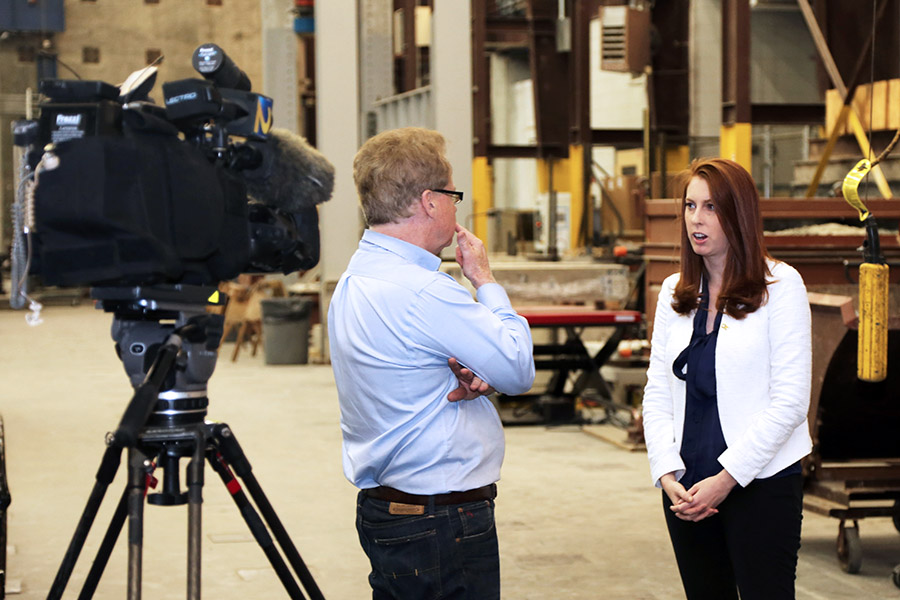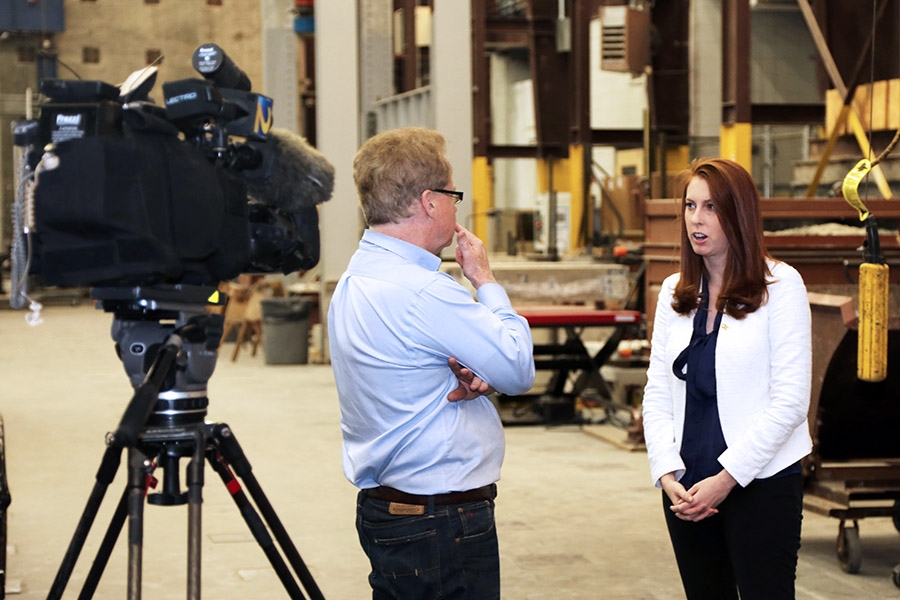 Lauren Stewart talks with WSB-TV's Tom Regan about the Interstate 85 bridge collapse in Atlanta. Stewart said coordinated investigations of the cause, cleanup of the site, and reconstruction of the highway will likely take months. She was among a handful of School of Civil and Environmental Engineering researchers who offered their engineering expertise to Atlanta and national media in the wake of the disaster. (Photo: Jess Hunt-Ralston) |
Reporters looking for insight into the collapse of the Interstate 85 bridge in Atlanta talked with half a dozen School of Civil and Environmental Engineering professors in the hours afterward in an effort to understand how the structure crumbled.
A 180-foot section of the highway fell in the heart of the city after materials stored underneath caught fire March 30. The pressing question for much of the city is how to get around the closed road, a major artery for residents and travelers. But there are also questions about why the bridge collapsed.
Professor Kimberly Kurtis told the Atlanta Journal-Constitution in the hours immediately after the collapse that she wasn’t familiar with the specific bridge, but “if this were a reinforced concrete structure, the fire would have had to burn long and hot to impact the steel (within).
“Once the temperature gets about one-third to half the temperature of the melting point of steel, that’s when you start to see more significant decreases” in its stability, said Kurtis, also an associate dean of the College of Engineering. The structure can no longer support the load they were designed for at that point, she told WSB-TV. Meanwhile, concrete will start to crack, she said.
"Concrete is hydrated. It has water in its structure, so it's literally boiling. It's trapped within the concrete and the only way to escape is to create cracks," Kurtis said.
What’s more, the damage could extend beyond solely the collapsed section, said Reginald DesRoches, the Karen and John Huff School Chair.
“The surrounding sections of the highway will be evaluated to determine if any damage was sustained from the heat,” DesRoches told CNN. “It is probably prudent to check both sides of the adjacent sections — northbound and southbound."
Lauren Stewart, in a round robin of conversations with the Associated Press, Atlanta TV stations WSB and 11Alive, and the New York Times, said the evaluation and repair process will stretch into months.
“You’ll have coordination on investigations about the cause of the fire on the federal and state agency side, and then you’ll also have coordination with engineers to determine the level and extent of the damage,” Stewart told the AP. “Then, if they have to clean up the area and deconstruct some of the bridge, that will happen. Then they will start the rebuild.”
In the meantime, Atlanta’s notoriously bad traffic will likely get worse, according to Michael Hunter, who studies travel behavior and transportation engineering.
“[I-85 is] one of the critical corridors in Atlanta, and really in Georgia,” he told the Times and USA Today. So all of the traffic normally traveling the highway will start to clog the alternate routes, some of which already are jammed.
“This is going to be significant and cause a ripple effect,” he said. “You’re going to see congestion all over Atlanta where it isn’t, normally.”
Randall Guensler told the AJC's Bill Torpy he's optimistic the city's roads will ultimately be able to absorb all the people searching for alternate ways to get around.
“I think it’ll just be a little less convenient,” he said.
And there could be a silver lining, according to Kari Watkins, who told energy and environment news website E&E News the jolt to commuters' daily routines could be an opportunity to get them using the city's transit system — and shift their behavior more permanently.

